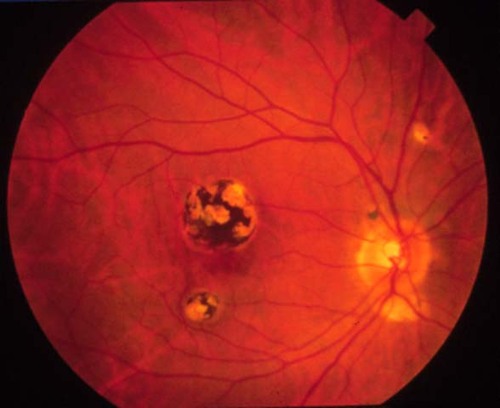Retina/Uveitis Quiz 15

Figure 1
This is the right eye of a patient complaining of decreased vision.
This is the right eye of a patient complaining of decreased vision.
Answer: Ocular histolplasmosis
2. What geographic regions are considered edemic for this diagnosis?
Answer: Ohio and Mississippi River valleys. Sixty percent or more of the young adult, lifelong, residents react positively to histoplasmin skin testing.
3. What are the definitions of extrafoveal subretinal neovascular membranes (SRNVM) and juxtafoveal SRNVM according to the macular photocoagulation study (MPS)?
Answer: Extrafoveal SRNVMs are defined as HAVING hyperfluorescence on fluorescein angiography 200 to 2500 microns FROM the center of the foveal avascular zone. Juxtafoveal SRNVMs are defined as HAVING a hyperfluorescent edge 1 to 200 microns FROM the center of the foveal avascular zone or an SRNVM 200 to 2500 microns FROM the center, with blood or blocked fluorescence within 200 microns of the center.
4. What were the findings of the MPS regarding extrafoveal SRNVMs?
Answer: At 24 months, a 6-line visual loss had occurred in 50 % of the GROUP receiving no treatment and 22 percent of the treated group. The effectiveness of laser treatment when compared with controls was present in all subgroups at all stages of follow-up.
5. What were the findings of MPS regarding juxtafoveal SRNVMs?
Answer: At 1 year follow-up, the risk of a 6-line visual loss was 24.8 % in the GROUP who received no treatment compared with 6.6 % in the treated group.
6. What are some complications of macular photocoagulation for SRNVMs?
Answer: The most important complication of the treatment of SRNVMs is recurrence of the membrane. Others include retinal pigment epithelial rips, acute choroidal hemorrhage, and nerve fiber layer field defects. Premacular fibroplasia and internal limiting membrane contracture may also occur and may lead to macular hole formation.